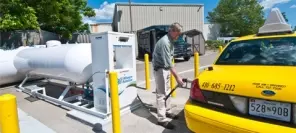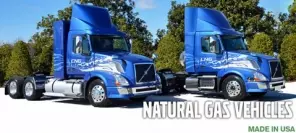- Main page
- Search
- Up to date
- Products
- Technology
- Vehicles
- Video
- Conversion Payback Simulator
Port Injection - Conversion Payback Simulator
Direct Injection - Conversion Payback Simulator
Diesel - Newsletter
Autogas as seen by Americans
 loading results...
loading results... © Thomas Built Buses
© Thomas Built Buses  © Thomas Built BusesIn the States, it’s easier nowadays to see a gas-powered bus than a gas-powered passenger car. Quite the opposite than on this side of the Atlantic!
© Thomas Built BusesIn the States, it’s easier nowadays to see a gas-powered bus than a gas-powered passenger car. Quite the opposite than on this side of the Atlantic!Looking from the point of view of potential profit and loss, Americans perceive autogas just like we do: it extends the engine’s life, reduces emissions of carbon dioxide and harmful components, and thanks to lower price per unit (despite lower economy figures) provides savings for the driver/fleet operator. The main issue is how big these savings are, because the decision to convert a car to LPG depends largely on it. And it looks like in the States the scale of the reduction in fuel costs depends mostly on who the purchaser of that fuel is, as the prices vary considerably depending on who is buying.
Individual users, who don’t even necessarily need LPG as engine fuel, but use it to heat their homes or power their grills, pay for it almost the same as for petrol. It looks different with fleets that buy large amounts of gas. They can count on good discounts with suppliers and on federal tax bonuses. Thus, a gallon (about 3,8 liters) of LPG costs $1,14 (which is about 1/3 of the price of petrol) minus additional 50 cents, which gives us 64 cents/gallon – about 20% of classic fuel’s price. Sounds great!
Thanks to such prices, not only do gas vehicles produce significant savings, but also they generate some money. In Flint, MI, a city struggling with the effects of the economic downturn, a fleet of gas-powered buses generates costs of 13 cents/mile, whereas similar diesel vehicles would be three times as expensive to maintain at 41 cents/mile. So, considering ticket prices, buses in Flint generate more income than expenses. And that’s how it should be!
It’s probably no surprise for anyone that the rise in interest in the area of autogas across the Atlantic is a direct result of the technological revolution in shale gas excavation. Five years ago, LPG was mainly produced through refining of crude oil, so the price of liquefied gas was closely linked to the price of oil. Today, the main source of LPG lies in shale deposits of methane which are so big that the States are not able to “consume” their own production of propane-butane. They can’t even handle the export entirely, so the surplus product goes… back into the ground! Why importers from countries like Poland don’t get gas from that area?
The enthusiasm of some potential customers who would like to start saving is cooled down by the initial costs. Converting a truck means spending around $10000, building your own station costs $50000. But the calculations usually show that such investments pay off quickly. Student Transportation of America operates a fleet of 10000 school buses in 16 states in the USA, as well as in Ontario, Canada. 435 of those vehicles, which operate in Omaha, NE, have been converted to LPG. Their owner pays $1,4 for every gallon of fuel, and the price includes the cost of creating and maintaining refueling infrastructure. And still, the price of LPG is less than half the price of diesel. Savings go to schools that, thanks to this, can afford to renovate their facilities and provide students with teaching aids that they need in order to learn more effectively and in better conditions.
 © WikimediaIt was easier to buy an LPG-powered car in the States 30 years ago than it is today, but that may change quite soon
© WikimediaIt was easier to buy an LPG-powered car in the States 30 years ago than it is today, but that may change quite soonDue to the properties of LPG and the effect it has on the engines, the savings are not limited to lower fuel bills. Thanks to the “purer” combustion process, fleet operators can afford to extend the maintenance intervals in their vehicles from 4000 to 7000 miles. Besides, gas engines have less capacious lubrication systems than their diesel counterparts, so not only does oil need to be changed less frequently, but also smaller amounts of it are needed. During six years when the vehicle is used in a fleet, it will provide a significant reduction of costs, and it will be good for the environment as well (because used oil must be still somehow disposed of). And of course we must remember about the reduced CO2 emissions. Dish Network converted 200 of its 5000 vehicles to gas power and the reduction of greenhouse gas emissions was at a level comparable to growing 200 thousand new trees that absorb carbon dioxide from the atmosphere.
And what about individual drivers? First of all, the price of LPG for them is not as attractive as for fleet operators. It may change quickly thanks to the surplus of the product on the market, but there’s still the issue of insufficiently developed infrastructure. There are only about 2500 public LPG refueling stations in the States, which is a tiny drop in the sea of possibilities (not needs, as there won’t be any as long as there aren’t more stations built). The chances of development are not so obvious, as the industry remains divided. It lacks coordinated actions and long-term support policy. There are some local initiatives, but they are obviously limited and vary in effectiveness. Big oil companies got interested in compressed natural gas (e.g. ExxonMobil), supporting the industry with their money and logistics. LPG still waits for a “helping hand” (though it must be said that there are some new autogas industry organizations that try to slowly consolidate the sector and spread it nationwide). A breakthrough must come sooner or later because pumping the fuel back into the ground makes no sense in the situation when it might help millions of people to drive cheaper and harm the environment much less.






